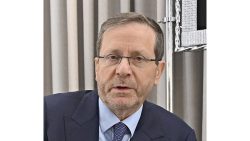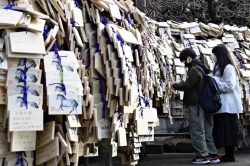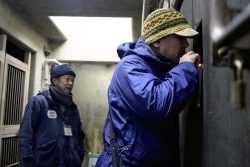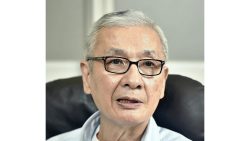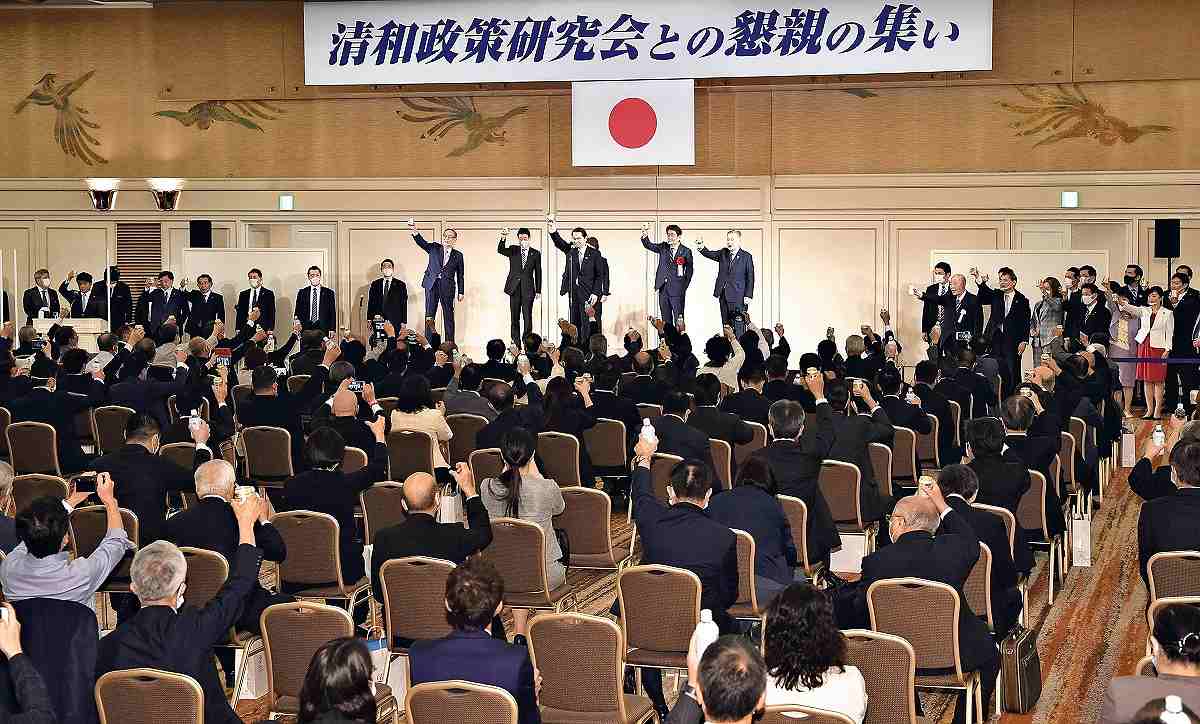
The Hosoda faction, the Liberal Democratic Party’s largest group, holds a meeting in September in Minato Ward, Tokyo.
12:52 JST, December 4, 2020
This is the fifth installment in a series examining the current state of the Liberal Democratic Party by looking at factions that were in the spotlight during the party’s presidential election this year.
***
The shock reverberated throughout the faction of Hiroyuki Hosoda, the largest in the Liberal Democratic Party and producer of four prime ministers since 2000.
My office is offering its complete cooperation. At this stage, I cannot give an answer.
Former Prime Minister Shinzo Abe, originally from the Hosoda faction, spoke sparingly in reply to a question in the Diet Building on Nov. 24. The grilling was over dinners held the night before cherry blossom viewing parties thrown by Abe’s political organization, for which an aide admitted that the organization shouldered part of the costs.
The special investigation squad of the Tokyo District Public Prosecutors Office is on the case, suspecting a violation of the Political Funds Control Law.
Mr. Abe can’t return to the faction any time soon, a mid-ranking faction member lamented. “I thought there might be a third time as prime minister.”
About two months had passed since Abe stepped down due to a worsening of the chronic disease of ulcerative colitis. Inside the Hosoda faction, members voiced expectations that Abe would quickly rejoin the faction.
In the administration of Prime Minister Yoshihide Suga, a faction led by Toshihiro Nikai holds sway. The Hosoda faction was able to place five members in the Cabinet, but was bypassed for the key posts of LDP secretary general and chief cabinet secretary.
The 98-member strong faction had been united by the single purpose of supporting the Abe administration. Without Abe’s weight behind it, a sense of crisis is spreading that the faction “will fracture,” said a senior Hosoda faction member.
On Nov. 12, the Hosoda faction held a conference in an auditorium of the Diet Building. When Abe entered the room, the 70 or so members in attendance gave him a standing ovation.
Welcome back, Hiroshige Seko, secretary general of the LDP caucus in the House of Councillors, said in greeting Abe, to which the former prime minister retorted in jest, “I came because I don’t have anything else to do.”
Abe gave a speech on diplomacy for about 30 minutes. When the date of the conference was decided, the number of attendees ballooned and the venue was hurriedly switched from a room in the LDP headquarters building. Abe’s health condition had steadily improved, and he often showed his face at parties held by junior faction members.
I want to return to the faction next year, maybe even within this fiscal year, Abe had revealed to aides. But the dinner party scandal has derailed that plan.
In addition, the largest LDP faction has another issue to confront. It has no one to stand as a candidate for LDP president who can gain a consensus.
In the LDP presidential election held in September, Hakubun Shimomura, chair of the party’s Policy Research Council, indicated an eagerness to run, saying, “I have secured 20 who will recommend me.”
Although he was persuaded to withdraw his candidacy by faction leader Hosoda, Shimomura has repeatedly dined with mid-ranked and junior members of the faction, building a base of support for a run in the party presidential election to be held in September next year.
Other names that have come up are former Defense Minister Tomomi Inada; Yasutoshi Nishimura, minister in charge of economic revitalization; and Education, Culture, Sports, Science and Technology Minister Koichi Hagiuda.
However, there is no momentum within the faction for any of the four to build a unifying consensus.
Under such circumstances, one who is beginning to stand out is Seko, who is the leader of the Seifukai, a 36-member group within the faction comprised of upper house members.
After Abe announced his resignation as prime minister on Aug. 28, Seko needed just three days to collect signed letters of proxy from all members of Seifukai, stating that they entrusted Seko to act on their behalf. One lawmaker from a rural area even traveled all the way to Tokyo just to sign the document.
The move was aimed at deterring Shimomura and others who were expressing willingness to run by showing the faction’s unity in the upper house. Seko had already consulted with Hosoda about the decision that the faction would not field a candidate in the latest LDP presidential election.
The upper house members tend to be up for grabs, Seko told aides. “I need to make a preemptive strike.”
During the LDP presidential campaign period, the Seifukai booked a hotel conference room and its members met there every day.
On the evening of Oct. 28, Seko and Hirokazu Matsuno, head of the faction’s secretariat, met with eight junior members of the faction from both the lower and upper houses.
Seko and Matsuno spoke about such past experiences as the so-called Kato Rebellion, in which former party Secretary General Koichi Kato and his aides demanded the resignation of then Prime Minister Yoshiro Mori. Kato and his aides aligned with a no-confidence motion against the Mori Cabinet submitted by opposition parties, but were eventually suppressed.
Seko concluded the meeting by saying, “In a political battle, it’s important to be united.”
Mori, who still wields influence in the Hosoda faction, once said, “The one who controls the upper house controls the faction.”
A former Cabinet minister belonging to the Hosoda faction said, “From here on, Mr. Seko is the key. The person he backs may become a candidate for LDP president.”
4 prime ministers since 2000
The origins of the Hosoda faction lie in the Tofu Sasshin Renmei, which was established by former Prime Minister Takeo Fukuda in 1962 from the core of a faction led by former Prime Minister Nobusuke Kishi.
Just after Fukuda stepped down as prime minister in 1979, he established the Seiwakai political group. The name of Seiwa is derived from a proverb meaning that clean politics calms the public. In 1998, the name was changed to Seiwa Seisaku Kenkyukai, meaning the Seiwa policy research group.
The Hosoda faction is regarded as the most hawkish faction in the LDP, and is eager to bring about an amending of the Constitution.
After Fukuda, it was a long time before the faction was able to produce a prime minister. In 2000, Yoshiro Mori started the ball rolling, and Junichiro Koizumi, Shinzo Abe and Yasuo Fukuda followed in becoming prime minister. The four served a combined 16 years in the top position.
There are two bloodlines within the faction. One is the Abe line stemming from Shintaro Abe, the father of Shinzo Abe and the second leader of the faction, and the other is the Fukuda line with members close to Fukuda.
The LDP presidential race of 2012 was fought along these lines, in which Shinzo Abe clashed with faction leader and former Chief Cabinet Secretary Nobutaka Machimura.
"Politics" POPULAR ARTICLE
-

Japanese Language Requirement Eyed for Permanent Residency Status; LDP Plans Revisions of Laws on Foreigners
-
-250x167.jpg)
Japan Eyes Plan to Accept Up To 1.23 Mil. Foreign Workers by End of Fiscal 2028
-
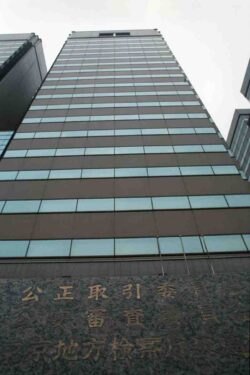
AI-Driven ‘Zero Clicks’ Phenomenon Threatens Democracy; News Outlets Must Be Able to Recover Costs, Stay Independent
-

Japanese Public, Private Sectors to Partner on ¥3 Tril. Project to Develop Domestic AI, SoftBank to Be Key Firm Involved
-

Japan’s Defense Ministry to Extend Reemployment Support for SDF Personnel to Age 65; Move Comes Amid Ongoing Labor Shortage
JN ACCESS RANKING
-

As Chinese Tourists Shun Japan, Hotels and Stores Suffer
-

Core Inflation in Tokyo Slows in December but Stays above BOJ Target
-

BOJ Gov. Ueda: Highly Likely Mechanism for Rising Wages, Prices Will Be Maintained
-

Osaka-Kansai Expo’s Economic Impact Estimated at ¥3.6 Trillion, Takes Actual Visitor Numbers into Account
-

Japan Govt Adopts Measures to Curb Mega Solar Power Plant Projects Amid Environmental Concerns







